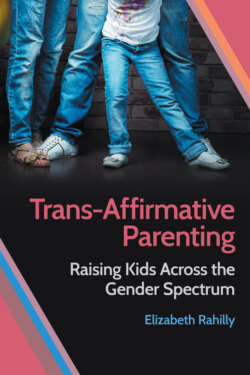Читать книгу Trans-Affirmative Parenting - Elizabeth Rahilly - Страница 9
На сайте Литреса книга снята с продажи.
The Parents
ОглавлениеThe overall sample in this book represents an amalgam of different groups of parents, recruitment venues, and snapshots in time between 2009 and 2015, both within these families’ lives and within the broader historical context of the last ten to twenty years. Broadly, there were two rounds of recruitment and interviewing for the project, resulting in two main parental groups or “cohorts.” First, I interviewed an original group of parents in 2009–11, representing thirteen childhood cases. I conducted follow-up interviews with these parents several years later (2012–13), which I refer to as the “follow-up” group throughout this book. Then, I interviewed a much larger group of parents during 2013–15, which entailed thirty new childhood cases. All told, the stories showcased in this book concern the forty-three cases from the cumulative sample (2012–15), inclusive of fifty-five parents (plus one eighteen-year-old sibling). Children ranged in age from five to eighteen years at the time of the interviews; the average age of the child was eight.
I recruited these parents, in part, from two annual conferences held by a major advocacy organization, which were designed to educate, support, and affirm parents and gender-nonconforming children. I also reached parents via online parent blogs and, indirectly, via online listservs and local parent support groups of parents I already knew. As a nonparent, I did not have direct access to support groups or online forums—a boundary I strictly observed—and parents posted blurbs on my behalf instead. Given my recruitment avenues, this book is limited to a very specific, “purposive” subpopulation of parents, who were immersed in a particularly affirmative set of discourses, practices, and advocacy communities.20 As such, these families do not represent all parents who have gender-nonconforming children, who exhibit variable degrees of support and affirmation. There are other kids, for example, outside this book, who must leave their families to live as their most authentic selves, a very different scenario from the stories showcased here.21
Geographically, more than half of the families (twenty-three) resided in California, while the rest came from various locations throughout the United States and Canada. Regionality is an important factor in LGBTQ studies.22 Some of the parents felt they lived in more “conservative” parts of the United States, but many of the families came from areas that could be characterized as “liberal,” especially those from California, which has been a forerunner in LGBTQ-inclusive legislation. This also certainly impacted the kinds of stories I collected and the degree of trans-affirmative parenting represented in the book.
Racially, the majority of parents were white-identified (just over 80 percent of participants). Nine of the parents were persons of color: four were biracial (including one white/African American, two white/Latinx, and one white/Middle Eastern), and five parents were Latinx.23 However, this does not reflect the ethnoracial profiles of the children: several white parents, for example, adopted children of color (American Indian, Asian American, and Latinx), and several of the children are biracial, but only the white parent participated in interviews. The majority of households (thirty-six) were classified as middle-class to upper-middle-class. More specific demographic details are provided in appendix I.
Altogether, considering income, occupation, and education, the sample is predominantly white and middle-class to upper-middle-class. The focus of my analysis is parents’ shifting understandings of gender, sexuality, the binary, and the body. Though I draw on critical race perspectives in the context of medical care in chapter 4, more extensive racial analyses and comparisons of the interview data would require a more diverse research sample. Nevertheless, parents’ raced and classed positions certainly influenced the ways they were able to intensively advocate for their kids, which I discuss later.
